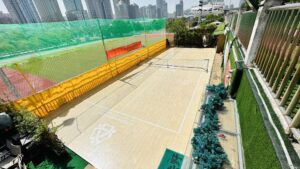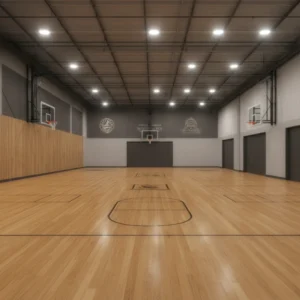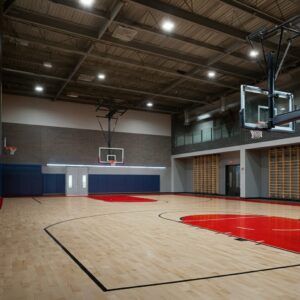Basketball is a sport of grace, skill, and relentless energy, captivating millions of fans worldwide. But as players grow faster, stronger, and more skilled, a thought-provoking question arises: Should basketball court dimensions be altered to make the game even more thrilling?
Modifying the size of the court could bring innovation to a sport steeped in tradition. From increasing player movement to offering logistical challenges, this debate has passionate arguments on both sides. In this blog, we’ll explore the history of basketball court dimensions, the pros and cons of making changes, expert perspectives, and the role advanced flooring solutions like Coposports biomass sport floor can play in enhancing gameplay.
A Brief History of Basketball Court Dimensions
Modern basketball courts adhere to standardized dimensions to ensure consistency in gameplay. An NBA court measures 94 feet by 50 feet, dimensions that have remained unchanged for decades. International courts, governed by FIBA, are slightly smaller, measuring 91.86 feet by 49.21 feet.
However, basketball didn’t always have such rigid specifications. When Dr. James Naismith invented the sport in 1891, the game was played on whatever space was available, from church gymnasiums to public halls. Over time, as basketball evolved into a structured sport, court dimensions were standardized to enhance fairness and gameplay.
Yet the sport has outgrown these dimensions in some ways. Today’s players are quicker, taller, and more dynamic. This progress has sparked questions about whether the traditional court size is still the best fit for modern basketball.
Arguments For Changing Court Dimensions
1. Increased Spacing and Player Movement
With today’s athletes reaching unprecedented levels of speed and agility, the court can feel cramped, limiting room for player movement. Expanding dimensions would create more spacing, resulting in a smoother and more dynamic game. With more space, we could witness newfound creativity in offensive maneuvers and breathtaking plays.
2. Enhanced Offensive Opportunities
A wider and longer court opens the door for more offensive possibilities. Picture well-executed cross-court passes, strategic isolation plays, and uncontested three-point shots. A larger playing area could lead to higher-scoring games, packing even more excitement into the hardwood floors.
3. Reduced Congestion in the Paint
The restricted area, also known as “the paint,” often sees heavy congestion in high-stakes games. By spreading defensive players over a larger space, you could create more opportunities for easy baskets, powerful dunks, and elegant layups, making the game more visually thrilling for fans.

Arguments Against Changing Court Dimensions
1. Disruption to the Game’s Traditions
Basketball enthusiasts deeply value the sport’s legacy, and court dimensions are part of its identity. Changing this aspect might alienate purists and disrupt the emotional connection fans have with the game.
2. Potential Impact on Defensive Strategy
Defense in basketball requires rapid positioning and teamwork within a compact area. A larger court could stretch defenses too thin. Defenders would struggle to guard against fast breaks and pinpoint shooting, which could tip the competitive balance substantially in favor of offensive plays.
3. Logistical Challenges and Costs
Perhaps the most glaring obstacle to changing court dimensions lies in its implementation. Transitioning to new standards would require modifications to thousands of venues worldwide, not to mention adjusting hardwood sport floors, seating arrangements, and broadcasting setups. This would be a monumental investment for high school gyms, collegiate arenas, and professional venues alike.
Expert Opinions on Court Dimensions
What do those closest to the game think about changing the court dimensions? Here’s what a few experts have to say:
- Greg Popovich, Renowned NBA Coach, remarked, “While widening the court could boost offense, it would fundamentally change how we strategize on defense, which makes basketball the balanced sport it is.”
- Jessica Torres, Sports Performance Analyst, shared, “Modern players have evolved beyond what the original court size intended. Finding a middle ground might ensure the game reflects today’s athleticism.”
- Marcus Kane, Former Collegiate Player, added, “Growing up, the courts shaped how we learned the game. It’s hard to imagine how altering dimensions would affect future generations of players.”
The mixed perspectives from players, analysts, and coaches underline the complexity of such a change. For every touch of innovation added, some tradition may be lost.
Beyond Dimensions: The Role of Modern Flooring
Innovation doesn’t always have to mean changing the dimensions of the game. Advancements in basketball court flooring, such as Coposports biomass sport floor, offer performance improvements without altering the core of the sport.
These cutting-edge surfaces enhance gameplay by offering:
- Improved Grip and Safety: Better traction reduces injuries while supporting player performance during explosive movements.
- Durable Design: Modern court floors are built to withstand intense gameplay, ensuring long-lasting quality for arenas and gyms.
- Sustainability: Biomass sport floors are eco-friendly, contributing to greener sports facilities without compromising player experience.
Upgrading to advanced flooring solutions is a subtle but powerful way to uplift basketball for athletes and fans, preserving tradition while introducing much-needed modernity.
FAQs About Basketball Court Dimensions
1. What are the official NBA court dimensions?
An NBA court is 94 feet by 50 feet, with a 23.75-foot three-point arc from the basket at the top, narrowing to 22 feet at the corners.
2. Are high school courts smaller?
Yes, most high school courts are 84 feet by 50 feet, making them more suitable for younger players in smaller venues.
3. How do FIBA courts differ from NBA courts?
FIBA courts are slightly smaller, measuring 91.86 feet by 49.21 feet. The three-point line is also closer to the basket than it is on NBA courts.
4. Could larger courts affect TV broadcasts?
Expanded courts could require adjustments to camera angles, lighting, and arena seating, presenting technical and financial challenges for broadcasters.
5. How does modern flooring contribute to better basketball?
Innovative floors like Coposports biomass sport floor provide superior durability, grip, and sustainability, ensuring peak athlete performance on the court.

Rethinking Basketball, One Step at a Time
Basketball’s legacy is built on a balance of tradition and innovation. While changing court dimensions could unlock new potential for the sport, it also comes with challenges that directly impact the game as we know it. Instead, focusing on advancements like eco-friendly court flooring could be a smarter step forward, enhancing gameplay without altering the essence of basketball.
Curious about how advanced basketball court solutions could elevate your facility? Explore Coposports hardwood sport floors today and take your courts to the next level.









